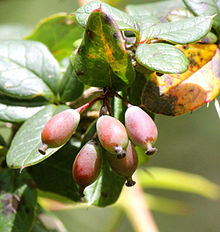Tarnished barberry
| Tarnished barberry | ||||||||||||
|---|---|---|---|---|---|---|---|---|---|---|---|---|

Burnt barberry ( Berberis aristata ) |
||||||||||||
| Systematics | ||||||||||||
|
||||||||||||
| Scientific name | ||||||||||||
| Berberis aristata | ||||||||||||
| DC. |
The Berberis aristata ( Berberis aristata ) is a plant from the family of Barberry (Berberidaceae). It is native to northern India , Pakistan , Nepal and Bhutan .
description
The awned barberry is a deciduous shrub that reaches heights of up to three meters. The bare and round branches of the shrub are bent over, and initially yellowish or reddish brown, later gray. The thorns are one to three parts and up to 3 inches long.
The leaves are dull green on the top and light green to whitish on the underside and are obovate to elliptical, blunt or pointed, with 3 to 5 thorns on both sides, up to 6 centimeters long, clearly veined on both sides. In autumn they are colored fiery red.
The vivid yellow flowers with reddish color on the outside appear in May in 10 to 25 bunches of up to 10 centimeters long. The elongated berries are bright red in color and have a strong bluish tinge.
The number of chromosomes is 2n = 28.
use
This species and its varieties are used as an ornamental shrub in gardens and parks.
Systematics
A synonym for the species is Berberis chitria Ker Gawl.
With the common barberry ( Berberis vulgaris ) the awned barberry forms the hybrid Berberis × macracantha Schrad.
literature
- Andreas Roloff , Andreas Bärtels: Flora of the woods. Purpose, properties and use . 2nd, completely revised edition. Eugen Ulmer, Stuttgart (Hohenheim) 2006, ISBN 3-8001-4832-3 .
- Robert Zander : Zander. Concise dictionary of plant names. Edited by Walter Erhardt , Erich Götz, Nils Bödeker, Siegmund Seybold . 17th edition. Eugen Ulmer, Stuttgart 2002, ISBN 3-8001-3573-6 .
Individual evidence
- ↑ Berberis aristata at Tropicos.org. In: IPCN Chromosome Reports . Missouri Botanical Garden, St. Louis

